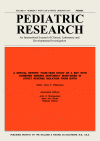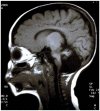Genetics of SCID
- PMID: 21078154
- PMCID: PMC2999594
- DOI: 10.1186/1824-7288-36-76
Genetics of SCID
Abstract
Human SCID (Severe Combined Immunodeficiency) is a prenatal disorder of T lymphocyte development, that depends on the expression of numerous genes. The knowledge of the genetic basis of SCID is essential for diagnosis (e.g., clinical phenotype, lymphocyte profile) and treatment (e.g., use and type of pre-hematopoietic stem cell transplant conditioning).Over the last years novel genetic defects causing SCID have been discovered, and the molecular and immunological mechanisms of SCID have been better characterized. Distinct forms of SCID show both common and peculiar (e.g., absence or presence of nonimmunological features) aspects, and they are currently classified into six groups according to prevalent pathophysiological mechanisms: impaired cytokine-mediated signaling; pre-T cell receptor defects; increased lymphocyte apoptosis; defects in thymus embryogenesis; impaired calcium flux; other mechanisms.This review is the updated, extended and largely modified translation of the article "Cossu F: Le basi genetiche delle SCID", originally published in Italian language in the journal "Prospettive in Pediatria" 2009, 156:228-238.
Figures








Similar articles
-
Long term outcomes of severe combined immunodeficiency: therapy implications.Expert Rev Clin Immunol. 2017 Nov;13(11):1029-1040. doi: 10.1080/1744666X.2017.1381558. Epub 2017 Sep 23. Expert Rev Clin Immunol. 2017. PMID: 28918671 Free PMC article. Review.
-
Severe combined immunodeficiency (SCID): from molecular basis to clinical management.Acta Biomed. 2011 Apr;82(1):5-13. Acta Biomed. 2011. PMID: 22069950 Review.
-
Genetically-determined defects of T cell development.Allergy Asthma Proc. 2024 Sep 1;45(5):326-331. doi: 10.2500/aap.2024.45.240028. Allergy Asthma Proc. 2024. PMID: 39294907 Free PMC article. Review.
-
Gene therapy for severe combined immunodeficiency.Annu Rev Med. 2005;56:585-602. doi: 10.1146/annurev.med.56.090203.104142. Annu Rev Med. 2005. PMID: 15660528 Review.
-
The case for mandatory newborn screening for severe combined immunodeficiency (SCID).J Clin Immunol. 2014 May;34(4):393-7. doi: 10.1007/s10875-014-0029-0. Epub 2014 Apr 2. J Clin Immunol. 2014. PMID: 24691999 Review.
Cited by
-
EFFECT OF GENOTYPE AND AGE ON A DEFINED MICROBIOTA IN GNOTOBIOTIC SCID PIGLETS.bioRxiv [Preprint]. 2024 Sep 7:2024.09.03.611011. doi: 10.1101/2024.09.03.611011. bioRxiv. 2024. PMID: 39282343 Free PMC article. Preprint.
-
T Cell Lymphoma and Leukemia in Severe Combined Immunodeficiency Pigs following Bone Marrow Transplantation: A Case Report.Front Immunol. 2017 Jul 12;8:813. doi: 10.3389/fimmu.2017.00813. eCollection 2017. Front Immunol. 2017. PMID: 28747915 Free PMC article.
-
Clinical, Immunological, and Molecular Findings in 57 Patients With Severe Combined Immunodeficiency (SCID) From India.Front Immunol. 2019 Feb 4;10:23. doi: 10.3389/fimmu.2019.00023. eCollection 2019. Front Immunol. 2019. PMID: 30778343 Free PMC article.
-
Creating effective biocontainment facilities and maintenance protocols for raising specific pathogen-free, severe combined immunodeficient (SCID) pigs.Lab Anim. 2018 Aug;52(4):402-412. doi: 10.1177/0023677217750691. Epub 2018 Jan 11. Lab Anim. 2018. PMID: 29325489 Free PMC article.
-
A hypomorphic recombination-activating gene 1 (RAG1) mutation resulting in a phenotype resembling common variable immunodeficiency.J Allergy Clin Immunol. 2014 Dec;134(6):1375-1380. doi: 10.1016/j.jaci.2014.04.042. Epub 2014 Jul 2. J Allergy Clin Immunol. 2014. PMID: 24996264 Free PMC article.
References
-
- Cossu F. Le basi genetiche delle SCID. Prospettive in Pediatria. 2009;156:228–238.
-
- Ochs HD, Smith CIE, Puck J. Primary Immunodeficiency Diseases: A Molecular and Genetic Approach. New York: Oxford University Press; 2007.
-
- Stiehm ER, Ochs HD, Winkelstein JA. Immunologic disorders in infants & children. Philadelphia, Pennsylvania: Elsevier Saunders; 2004.
-
- Baker MW, Laessig RH, Katcher ML, Routes JM, Grossman WJ, Verbsky J, Kurtycz DF, Brokopp CD. Implementing routine testing for severe combined immunodeficiency within Wisconsin's newborn screening program. Public Health Rep. 2010;125(Suppl 2):88–95. http://www.publichealthreports.org/archives/issueopen.cfm?articleID=2428 - PMC - PubMed
Publication types
MeSH terms
LinkOut - more resources
Full Text Sources
Other Literature Sources

